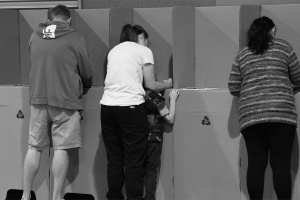Aussie science and innovation need immediate and sustained investment to power a future made in Australia
The Australian Academy of Technological Sciences and Engineering (ATSE) welcomes commitments in the Federal Budget to review Australia’s languishing investment in Australian science and innovation and back clean energy industries, however investment can’t be kicked further down the road.

Australia lags behind the United States, Japan, and Germany, who all spend more than 3% of their GDP on the research and development which powers their economies. Ultimately, Australia’s investment in R&D will make or break the Future Made In Australia investments announced tonight.
ATSE CEO Kylie Walker welcomed the Government’s strong commitment to developing Australia’s clean energy system which will power the industries and jobs of the future.
“Investments in battery manufacturing, renewable green hydrogen production and critical minerals processing are central to the nation’s net zero ambitions; these are areas where we have a comparative advantage in the global supply chain and which are fundamental for the jobs of the future.
“However, it is critical for the Government to recognise that developing these industries requires innovations that will only come from a strong and well-funded science and technology sector.
“ATSE also welcomes the announced review of Australia’s research and development system, as recommended in ATSE’s pre-budget submission. It is critical that this work gets underway to make up for lost time and to bring Australia closer to nations at the forefront of technological innovation,” said Kylie Walker.
The Academy also supports the $1.1 billion over five years for the first stage reforms of the Universities Accord, with a focus on equity and access to higher education. This includes the already announced measures to pay for selected student placements and limit the indexation of HECS-HELP loans.
“We welcome the development of a needs-based funding system which supports students who would typically miss out on a university education. We look forward to working with the government to design this system in a way that supports under-represented students and prepares the STEM workforce of the future.
“ATSE welcomes support for teaching students to undertake their unpaid work placements, and urges the Government to extend this support to university engineering students – in recognition of the dire shortage in engineers, whose skills will be critical to the clean energy transition,” said Kylie Walker.
The Academy also welcomes the following measures announced in this Budget:
Decarbonisation:
- $63.8 million over ten years from 2024–25 to support agricultural and land-based emission reductions
- An additional $76.2 million over five years from 2023–24 to support Australia’s engagement in international climate change and energy transition issues, and a bid to co-host COP31 in partnership with the Pacific.
- $399.1 million over 5 years for the Net Zero Economy Authority, including workforce transition support.
Water and environment:
- Funding over five years from 2023–24 to continue implementation of the Murray-Darling Basin Plan.
- $174.6 million over six years from 2024–25 to deliver new water infrastructure projects, and $26.1 million for First nations water infrastructure projects.
Education and skills:
- $91.0 million to develop the clean energy workforce
- $10.0 million in 2025–26 to establish a National Hydrogen Technology Skills Training Centre
- As part of Universities Accord reforms, $27.7 million to break down barriers between higher and vocational education
- $38.2 million for programs to increase diversity in STEM
- $101.8 million over seven years from 2024–25 to build a workforce to support the delivery of Australia’s nuclear-powered submarines
- $33.5 million over six years for initiatives aimed at enhancing domestic industry and workforce capacity
- $4.4 million in 2024-25 for Vocational Education and Training support, including the creation of 15,000 fee-free TAFE places and 5,000 places for pre-apprenticeships
- $18.7 million over four years from 2024–25 (and an additional $28.8 million from 2028–29 to 2034–35) to introduce a National Higher Education Code responding to gender-based Violence
- $55.6 million to launch the Building Women’s Careers program to create structural and cultural change in male-dominated workplaces.
Industry and research
- $549 million over 8 years for support of battery manufacturing and $20.3 million over 5 years for the Powering Australia Industry Growth Centre and Future Battery CRC
- $7.1 billion over 11 years in critical minerals processing tax incentives
- $8 billion in renewable hydrogen tax incentives over 10 years
- $6.8 million over two years to support the offshore oil and gas decommissioning strategy
- Extension of the Global Science and Technology Diplomacy Fund into the forward estimates
- an additional $1.4 billion over 13 years from 2024–25 through the Medical Research Future Fund (MRFF) to continue to invest in life-saving medical research in Australia
- $18.8 million over two years from 2024–25 to continue the development of the National One Stop Shop for Clinical Trials and Human Research
Digital technologies:
- $39.9 million to support the safe and responsible adoption and use of artificial intelligence (AI) technology
- $68 million for First Nations Digital Inclusion including the role out of WiFi for remote communities and a First Nations Digital Support Hub.
— ENDS —




